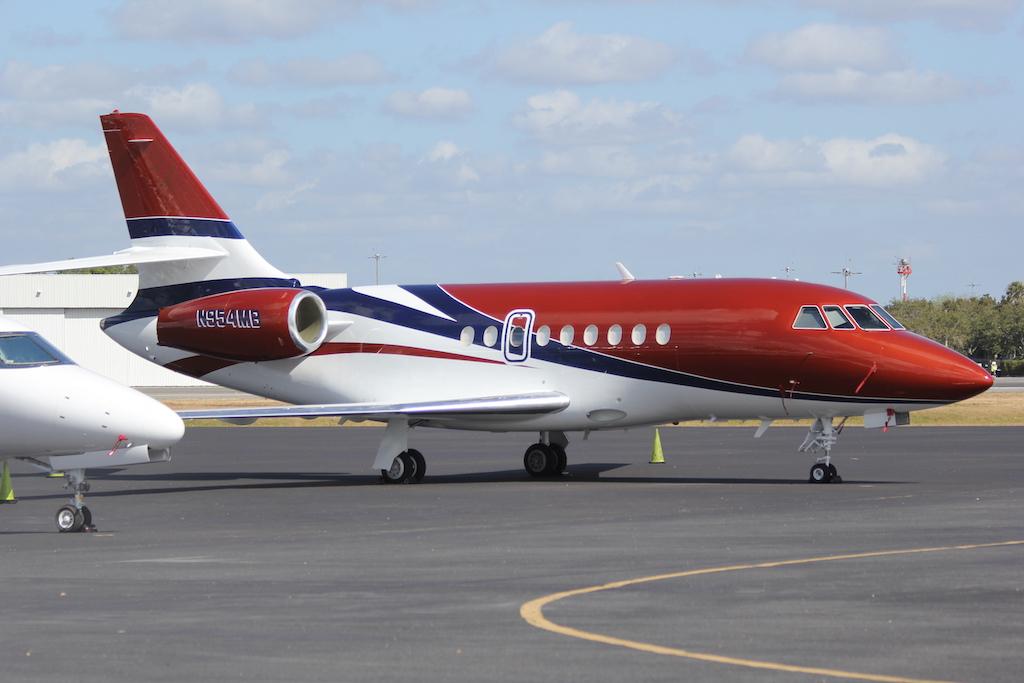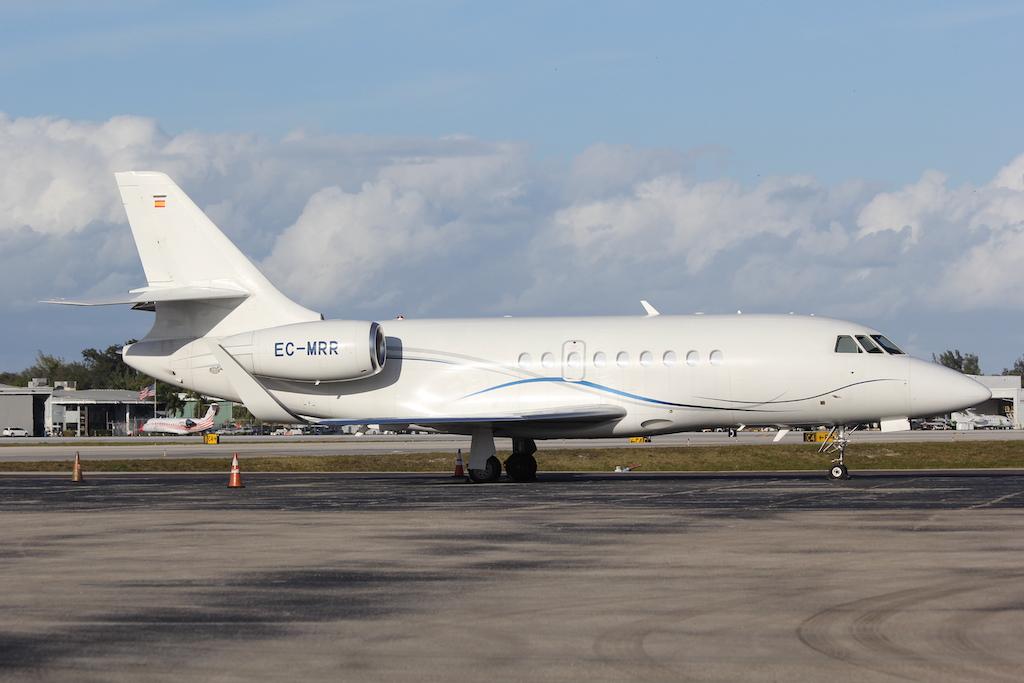
A legacy Dassault Falcon 2000 twinjet
The Dassault Falcon 2000 super midsize twinjet shared the wing and forward fuselage of the earlier Falcon 900 but subtracted the third engine. The 2000 series has seen continuous improvement in range and efficiency across seven variants since being introduced in 1995.
Over nearly three decades, the price of a new production Falcon 2000 has doubled. The factory-new list price of a Falcon 2000 in 1995 was $17.85 million, according to the Aircraft Bluebook. A 2022 Falcon 2000LXS lists for $35.1 million.
Powered by twin General Electric/AlliedSignal CFE738-1-1B2 engines, each generating 5,918 lb. of thrust, the original Falcon 2000 came with a 7-ft. shorter cabin than the Falcon 900, carried up to 10 passengers and flew to a range of 2,841 nm. The leading edge of the wing was modified from the 900’s and the inboard slats removed. The flight deck featured the Collins Pro Line 4 avionics suite.
New Engine And Avionics

Dassault introduced the Falcon 2000EX with 7,000-lb.-thrust Pratt & Whitney Canada 308C engines and range improvement to 3,878 nm in 2003. The Falcon 2000EX EASy followed in 2005; it replaced the Collins flight deck with the Honeywell Primus Epic-based EASy avionics suite, including synthetic vision system.
The manufacturer offered a shorter-range (3,250 nm) DX variant in 2008. The $28.5 million DX model delivered “the same spacious, quiet interior as its longer-range sibling, the 2000EX, but was developed for customers with less extensive city pair requirements,” Dassault said. “The design makes it the only business jet in its class capable of landing with fuel tanks nearly full.”
Blended Winglets

The Falcon 2000LX entered the market in 2009; it featured Aviation Partners’ blended winglets and increased maximum range to 4,000 nm with lower fuel consumption. Dassault unveiled the $27 million, 3,350-nm-range 2000S in 2013 as a lower-cost replacement for the 2000DX, with improved runway performance. The manufacturer also started production of the Falcon 2000LXS, which combines the 4,000 nm range of the LX model with the runway capabilities of the S model. The 2000LXS can fly six passengers and two crewmembers nonstop between New York and Rome at Mach 0.80, with a top speed of Mach 0.85.
The FAA and the European Union Aviation Safety Agency certified Dassault’s FalconEye combined vision system (CVS) for use in the Falcon 2000LXS and 900 in 2016. A CVS presents synthetic vision and infrared enhanced vision on a head-up display for improved visibility in adverse weather.
Dassault had delivered 675 Falcon 2000-series jets as of October, according to the Aviation Week Fleet Discovery Database. The breakdown across the fleet was: 236 Falcon 2000s, plus one in storage and two in possession of non-operators; four Falcon DXs; 383 Falcon 2000 EX/LX/LXS models, plus two in other hands; and 47 Falcon 2000S models.
“As the first super-midsize aircraft, the Falcon 2000 series strikes a great balance between cabin comfort, range, performance and operating costs,” says Eric Deye, vice president of aircraft brokerage with QS Partners. “More cost and fuel efficient than any of the three-zone competitors, the 4,000+ nm range 2000LX and LXS are very popular with operators who require trans-Atlantic capability with super-midsize operating economics.”
There were 16 pre-owned Falcon 2000-series jets offered for sale in October. These included 10 Falcon 2000s, which typically sell for between $4 million and $7 million, according to Deye. There were no listings for the 2000EX, which introduced the more powerful P&WC engines; most recent sales ranged from $9.5 million to $11 million. There were two models each of the 2000EX EASy with Honeywell avionics (selling for $9 million to $13 million); 2000LX ($14 million to $19 million); and 2000LXS ($24 million to $35 million), Deye says.
Falcon 2000s compete for sales with Bombardier Challenger 604/605/650 twinjets, according to Deye. Buyers also consider smaller Gulfstream G200/G280 twinjets due to their cabin conference group option, or larger Falcon 900 and Gulfstream G450 jets.
Ten-Passenger Cabin

The legacy Falcon 2000, 2000EX EASy and 2000LX have the same cabin width (7.7 ft.) and height (6.2 ft.). The Falcon 2000 cabin is 5 ft. longer (31.2 ft.) than its siblings (26.17 ft.) and has greater baggage volume (134 cu ft. vs. 131 cu. ft.).
Eighty-five percent of the fleet is configured for 10 passengers, with forward, four-place club seating and an aft four-place conference group opposite two-place club seating, Deye reports. Alternative configurations include an 8-passenger double club configuration or 9-passenger option with a forward, 4-place club and 3-place divan opposite a 2-place club. All jets feature an aft, private lavatory.
“The cabin, with low sounds levels, spacious seating for 10 and a full-service galley with ample space for a cabin attendant, are many of the fleet’s strongest attributes,” Deye says. “Passengers also appreciate the 4,000+ nm range of the winglet equipped, later-model aircraft and the ability to reach their destinations more quickly and efficiently than any of the comparable vintage competitors.”
BCA’s 2022 Operations Planning Guide estimates Falcon 2000LXS direct costs of $4,160 for a 600 nm mission, based on a nationwide average Jet-A fuel cost of $6.94 per gallon at the time of publication. Direct costs include mission fuel consumed, maintenance labor, parts and reserve costs apportioned to the actual flight time for the mission length.
The “most impactful” maintenance events on all Falcon 2000s are the 1C and 2C inspections, which occur every 6 and 12 years, respectively, and typically range in cost from $300,000-$900,000, Deye says. A landing gear overhaul is due every 12 years and adds approximately $300,000 to the 2C calendar check. Engine overhauls occur at either 6,000 hr. for the legacy 2000 or 7,000 hr. for the 2000EX and up.
BCA welcomes comment and insight from aircraft dealers and brokers for its monthly 20/Twenty pre-owned aircraft market feature. The focus aircraft for November 2022 is the Airbus Corporate Jet and for December 2022, the Piper M350. To participate, contact [email protected].





